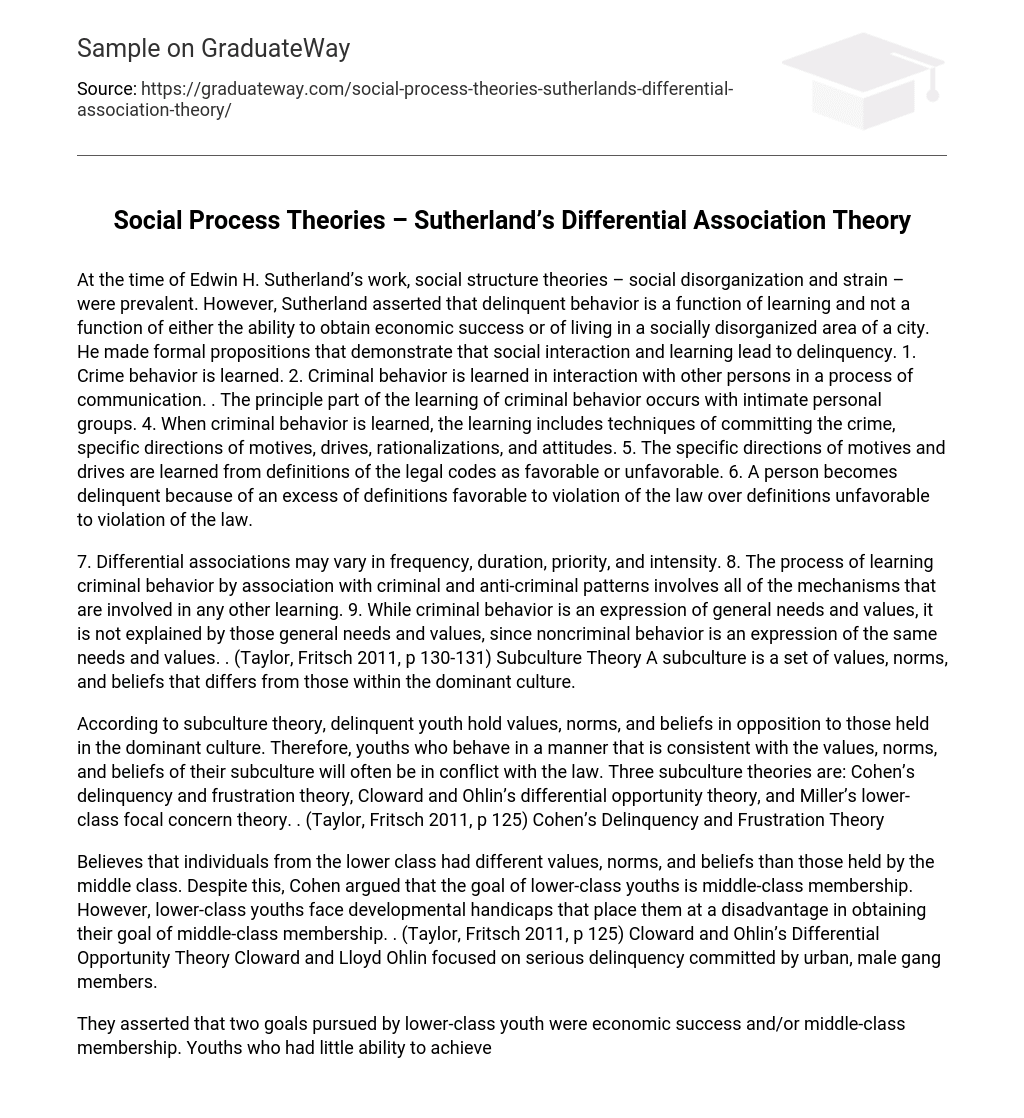During Edwin H. Sutherland’s time, prevailing social structure theories, such as social disorganization and strain, were dominant. However, Sutherland argued that delinquent behavior is a result of learning rather than the ability to achieve economic success or residing in a socially disorganized area of a city. He presented several formal propositions that illustrate how social interaction and learning contribute to delinquency:
- Crime behavior is acquired through learning.
- Criminal behavior is learned through communication and interaction with others.
- The most significant part of learning criminal behavior occurs within close personal groups.
- When learning criminal behavior, individuals also learn specific techniques, motivations, drives, rationalizations, and attitudes associated with committing crimes.
- Specific motives and drives are learned from the interpretation of legal codes as either favorable or unfavorable.
- An individual becomes delinquent when their acceptance of definitions favoring violation of the law outweighs those unfavorable to such violation.
7. Differential associations can vary in their frequency, duration, priority, and intensity.
8. The process of learning criminal behavior through associating with both criminal and anti-criminal patterns encompasses all the mechanisms involved in any other form of learning.
9. While criminal behavior is influenced by general needs and values, it cannot be solely explained by them, as noncriminal behavior also stems from the same needs and values. (Taylor, Fritsch 2011, p 130-131)
Subculture Theory suggests that a subculture consists of a distinct set of values, norms, and beliefs that differ from those found within the dominant culture.
The subculture theory explains that delinquent youth have values, norms, and beliefs that conflict with the dominant culture. As a result, these youths often break the law when their actions align with their specific subculture. Three well-known subculture theories are Cohen’s delinquency and frustration theory, Cloward and Ohlin’s differential opportunity theory, and Miller’s lower-class focal concern theory (Taylor & Fritsch 2011, p 125).
According to Cohen, individuals from the lower class have distinct values, norms, and beliefs compared to the middle class. However, he posited that lower-class youths aspire to achieve middle-class status. Unfortunately, these youths encounter developmental obstacles that hinder their ability to attain this goal of middle-class membership (Taylor, Fritsch 2011, p 125). Cloward and Ohlin’s Differential Opportunity Theory specifically addresses the involvement of urban male gang members in serious delinquency.
According to Taylor and Fritsch (2011, p 126-127), lower-class youth have two main goals: economic success and middle-class membership. If these goals cannot be achieved through legitimate means, some youths will form delinquent subcultures or join gangs in order to attain them. Walter B. Miller, an anthropologist who studied the lower-class areas of Boston in 1955, developed his lower-class focal concerns theory based on his field observations. Miller’s theory suggests that society is made up of different social groups, each with its own unique subculture (Taylor, Fritsch 2011, p 126-127).
In terms of delinquency, Miller highlighted the idea that young individuals may engage in unlawful behavior due to their adherence to certain norms and values that are prevalent within the lower-class society. Additionally, he explored elements that contribute to the formation of gangs and involvement in delinquent activities. Miller defined six key concerns that characterize the values of the lower-class subculture. These concerns distinguish the lower class from the middle and upper classes. The first concern is trouble, which refers to the evaluation of individuals based on their participation in disruptive actions.
2. Toughness – the value of physical strength, fighting ability, and masculinity.
3. Smartness – the value of being streetwise and able to con people.
4. Excitement – the value of seeking thrills through gambling, fighting, and getting intoxicated.
5. Fate – the value or belief that most things that happen to people are beyond their control.
6. Autonomy – the value of personal freedom resulting in an active disdain for authority.
(Taylor, Fritsch 2011, p 128-129)
Taylor, R., Fritsch, E. (2011) Juvenile Justice Policies, Programs, and Practices, The McGraw-Hill Companies, Inc.





